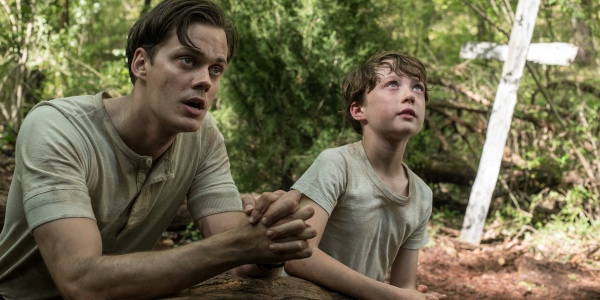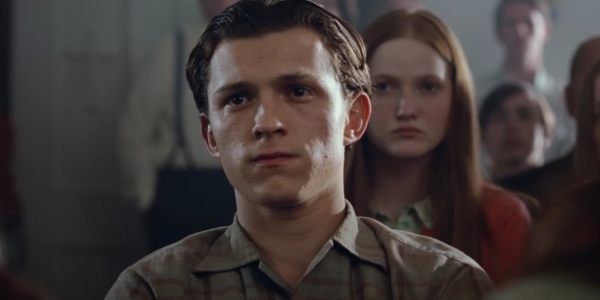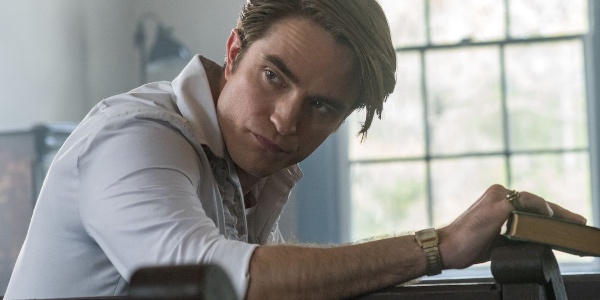THE DEVIL ALL THE TIME: A Visceral Look At Life After War
Everything and everyone was changed by World War II. Whether you were a soldier at war, a nurse in the Medic tents, a parent fearful of the loss of a son or a child left parentless, these effects did not end with the conclusion of the war, rather they were carried long after. In the memories of the horrors and the fear of loosing, some found a return to religion could ease their suffering, others brutality and corruption and still others struggled to find their way in a post-war world. These effects would not only ripple through the years that followed but through the coming generations as well. As the horrors of the past affected those growing in its aftermath, continued war, violence, and corruption only heightened. And as the world changed, many times, the smallest towns in the country did not.
While balancing each of these concepts, The Devil All the Time, from writer and director Antonio Campos, weaves a network of interconnectivity, the lives of one affecting others – even if they never meet. One decision, one frame of mind ripples out into the universe shaping the course of others, giving a seemingly predetermined destiny. If you are looking for an experiment in causal determinism, The Devil All the Time delivers. For many, this was always going to happen. As the film says, “Some people are just born to be buried”.
The Pebble in a Pond
The film begins in 1957, the introduction of Willard (Bill Skarsgård) arriving home to find his son Arvin (Michael Banks Repeta), age 9, has been bullied once again. Sporting a black eye as evidence, both make their way into the woods to Willard’s homemade cross and prayer spot. Instructed to pray, to be honest with the Lord, viewers are given a small insight into a moment that will become more horrific than viewers can anticipate. But to understand what is to come, the film must first go back.

Viewers are brought to Willard returning from the war, a subtle tension, and a quiet relief the only evidence of the horrors he has seen. Traveling home, he makes a stop in Meade, Ohio for a meal at a local diner. From this one moment, from this one stop, the lives of many, including Willard, are shaped and defined – marriages, death, and redemption all hanging on this one bus stop. Over time, characters will interlace with one another, weaving in and out of the film’s storyline. Viewers are left with little cliffhangers, waiting anxiously for characters to return, their narrative continued and their value revealed.
After a time, the film finally settles into its main focus point of Arvin (Holland), now grown up, the ripples of the past crashing in. It’s slow and intense at first, starting with his childhood and time with his father, moving on to his grandmother and his sister – wave after wave each ripple drawing closer and closer to his moment of adulthood and destiny. He has choices to make, ones that have been influenced by those who have come before and will continue to find their influence in those he still has to cross paths with.
Adapting The Devil All the Time
The Devil All the Time excels in its adaption, bringing the stories of many into a web of narrative timelines. While at times the transitions are a bit more abrupt than others, the film is wholly engaging. You want to know where each of these character’s story arcs brings them, and you want to know how it will all end. Yet it is not just the characters that will keep you locked in and engrossed. The Devil All the Time harbors a decent amount of gore and gut-wrenching moments – many of which you will find yourself struggling to maintain eye contact. As hard as they are to stomach, each of these only increases the desire to find out where the film could possibly go from here and what could possibly lie ahead. It also drives home hard the idea of brutality both in the war many brought home with them, and those embracing it for the first time.

As The Devil All the Time is a network of characters that interweave with one another, each action creating another, it is from one man where this all begins. For this execution, the film needed a cast that could not only own the depictions that they were given but bring them full circle. While some have a greater depth than others, there needed to be a solid commitment from all – and each and everyone delivers. Skarsgård and Haley Bennett not only clearly craft a home full of love and humble beginnings, but there is also a quiet tension Skarsgård infuses into his performance with each scene. There is trauma beneath the surface and an obsession with the potential power of the Lord that crescendos into an explosion of emotion from fear to despair to desperation. Jason Clarke and Riley Keough bring a devilishly playful villainy to their performances of two serial killers in the prime of their lives. While their screen time is rather limited, each is able to project growth in their character arc through the subtly of both dialogue and motion.
Yet as many of the performances were a standout, Holland and Robert Pattinson take the spotlight – especially Holland‘s performance. It was difficult to think such a hard, raw, and visceral performance could have come out of your friendly neighborhood Spiderman. Every ounce of knowledge and bit of experience has culminated into this one breakthrough moment – and it is not one to be missed. Pattinson is wickedly hypnotic. His southern accent bringing his voice to a different pitch, one that matches the unsettling subtly of movement. And while it will throw you off at first, you will find by the end of the film you never knew you needed it. It yearns for your trust while luring you into the false sense of security it delivers.
The Take Away
One of the biggest struggles with the film is its overall take away. Not because it is obscure but rather because it can be interpreted in many ways. There is this feeling of an attempt to reach back to the times before the war, returning to prayer and home life, all while a feeling of the horrors that have come to pass gives an allowance to some to bring the war home. You see the need for some to hold onto their religion, especially from those who have never left the small town they were born in, contrasted with those struggling with their faith as they break away from the security of their families and communities – seeing the war and the world giving a questioning of faith. Where the film could have teetered into judgmental, it maintains a balance focusing on the experiences of the individual characters, and what it means to them.

The Devil All the Time is heavy-handed with the idea of delusion, beyond the now Gif’ed Pattinson “Delusions”, that not everything is at it seems, that not everyone claiming to be good can be trusted, and not everyone that has been lured by the devil wants to continue onward. Delusions run rampant – what is good and what is evil? Could murder be considered good? Could a priest be trusted? Could sacrifice bring eternal salvation and life? The Devil All the Time asks you to question the perspective and to consider what the truth is.
Brutality and corruption also find themselves part of the conversation in The Devil All the Time. The violence one human can place on another rings loud, from the film’s opening moments to its conclusion. Interlaced in the brutality is the corruption that drives it. The need to maintain or acquire power. The ability to say who lives or dies. The power one yields to manipulate others into doing what they desire. These elements of humanity have always existed, in the past and in the present, but The Devil All the Time pushes viewers to look at it, consider it and discuss it.
Conclusion: The Devil All the Time
Adapted from Donald Ray Pollock‘s (also the film’s narrator) book of the same name, The Devil All the Time balances each story, giving it its time to flourish and each character’s contribution to the others to be fully realized. There is a lot to take in, but let the film take you along on this examination of opportunity, villainy, family, loneliness, religion and small-town living – one that will have you sorting out your emotions long after the film has ended.
Have you seen The Devil All the Time? What did you think? Let us know in the comments below!
The Devil All The Time will be released on Netflix on September 16, 2020.
Watch The Devil All The Time
Does content like this matter to you?
Become a Member and support film journalism. Unlock access to all of Film Inquiry`s great articles. Join a community of like-minded readers who are passionate about cinema – get access to our private members Network, give back to independent filmmakers, and more.
Join now!





